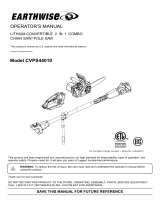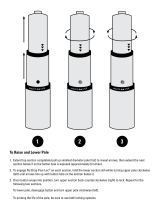
6 DR
®
PULSE 62V POLE SAW
Always charge the Battery Pack indoors, never charge it the rain or in wet conditions.
Use only the DR Lithium Charger with DR Lithium Battery Packs. Do not use the DR Lithium Charger with Battery Packs from
other manufacturers or other DR products. Use of a different Charger may cause a fire or explosion.
Never attempt to alter or open the Battery Pack or Charger. There are no customer serviceable parts inside. Use normal
household voltage (110 volts) when charging the Battery Pack. Plug the Charger Power Supply directly into the electrical outlet.
Exercise care in handling the Battery Pack in order not to short-circuit it with conducting materials such as rings, bracelets, and
keys. When short-circuited, the Battery Pack or conductor may overheat and cause burns.
Electrolyte leakage from the Battery Pack can be harmful causing serious chemical burns if on the skin or in the eyes. Remove
contaminated clothing and wash skin with soap and water. If electrolyte gets in your eyes, flush with cold water for at least 15
minutes and seek medical attention. Inhalation of vapors from a ruptured Battery Pack can cause respiratory irritation, provide
fresh air, and seek medical attention.
Never dispose of the Battery Pack in a fire, as the Battery Pack may explode. Never open or mutilate the Battery Pack; released
materials are flammable. If fire or explosion occurs, do not breathe the fumes. A burning Battery Pack will create toxic fumes.
Fire fighters should use self-contained breathing apparatus. The fire in the Battery Pack will need to burn out, but the fire can
be kept from spreading. If possible, separate the Battery Pack from other flammable materials and use sand, copper powder or
powdered graphite fire extinguishers, dry ground dolomite or soda ash to smother the fire.
Do not ship damaged Battery Packs and be sure to use the original packaging materials when shipping Batteries and tools back
to DR Power Equipment if you decide you do not want them. Special labeling on the packaging is required because the
Batteries are considered hazardous materials. Check with airlines before trying to check Lithium batteries with your baggage.
New regulations are being considered that may restrict packaging and shipping of these Batteries as well as tools with Batteries
installed.
Please dispose of your used Battery Packs responsibly by recycling them, never throw away used Battery Packs in your
household trash.
Please note that changes or modifications to this product not expressly approved by the party responsible for compliance could
void the user’s authority to operate the equipment.
NOTE: This equipment has been tested and found to comply with the limits for a class B digital device, pursuant to Part 15 of the
FCC rules. These limits are designed to provide reasonable protection against harmful interference in a residential installation.
This equipment generates, uses and can radiate radio frequency energy and, if not installed and used in accordance with the
instructions, may cause harmful interference to radio communications. However, there is no guarantee that interference will not
occur in a particular installation. If this equipment does cause harmful interference to radio or television reception, which can be
determined by turning the equipment off and on, the user is encouraged to try to correct the interference by one or more of the
following measures:
- Reorient or relocate the receiving antenna.
- Increase the separation between the equipment and the receiver.
- Connect the equipment into an outlet on a circuit different from that to which the receiver is connected.
- Consult the dealer or an experienced radio/TV technician for help.
Handling the Battery Pack Safely
FCC Warnings
No list of Warnings and Cautions can be all-inclusive. If situations occur not covered by this manual, the operator must apply
common sense and use the
DR
®
PULSE 62V POLE SAW in a safe manner. Visit our website at www.DRpower.com or call Toll Free:
1-800-DR-OWNER (376-9637) for assistance.























